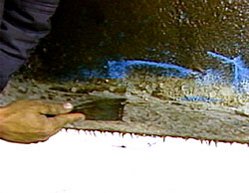Tributyltin (TBT) (Pollution)
Tributyltin (TBT)
There is particular concern about certain chemicals that can alter the development and functioning of the endocrine system at very low concentrations and affect reproduction. These chemicals are called “endocrine disruptors.” The first documented examples of endocrine disruption in estuarine environments were in dog whelks and mud snails, caused by the use of tributyltin (TBT) in antifouling paints used on boats. Antifouling paints are applied to boats to prevent algae, barnacles, etc. from attaching themselves to the boats and slowing their movement through the water; fouling can have great effects on the speed of a ship. Previously, copper was the main toxic ingredient; it functioned by leaching into the water preventing larvae from settling on the boats. In the 1960s and 70s, the organic tin compound TBT, more effective and long-lasting than copper, was developed as an antifouling ingredient. However, after years of use, it was discovered that tin-based chemicals at extremely low levels were causing female snails to develop male sexual organs and become sterile. Extensive use of these chemicals also caused oyster shells to develop abnormally, and eventually wiped out the oyster industry in parts of France. TBT use is now prohibited on most boats in most countries as a result of its devastating effects to marine invertebrates. Most boats are again being painted with copper-based paints that, while far from harmless, are much less toxic than TBT. Extensive efforts are underway to find non-toxic methods to prevent fouling.
Further reading
Barnacle Free Boats, ScienCentral News
